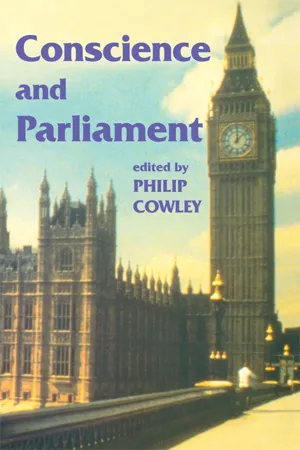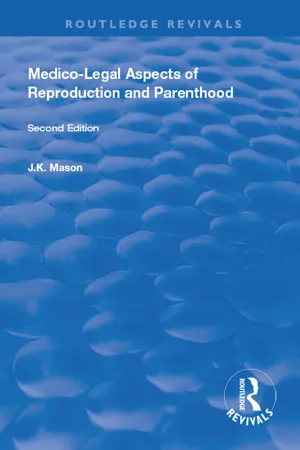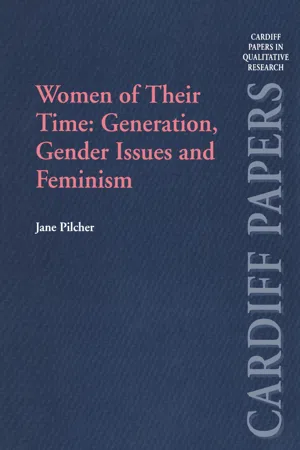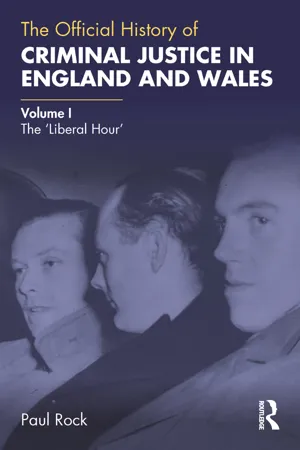History
Abortion Act 1967
The Abortion Act 1967 is a piece of legislation in the United Kingdom that legalized abortion under certain conditions. It allows for abortions to be performed by registered practitioners in National Health Service hospitals or licensed clinics. The Act sets out specific criteria for when an abortion can be carried out, including the need for two doctors to agree that continuing the pregnancy would risk the physical or mental health of the woman.
Written by Perlego with AI-assistance
Related key terms
8 Key excerpts on "Abortion Act 1967"
- eBook - ePub
- Claudia Carr(Author)
- 2014(Publication Date)
- Routledge(Publisher)
The case establishes that in common law, the restrictive statutory provisions against abortion could be circumvented in the case of necessity. This was, however, the exception rather than the norm. In any event, the defence is largely irrelevant in modern-day medicine as the defence of necessity is embodied in the most significant legislation – the Abortion Act 1967.9.1.6 The Abortion Act 1967The 1960s witnessed a general period of social and sexual enlightenment. One significant breakthrough in this decade was the introduction of the contraceptive pill. At a similar time there came an awareness that legislation was necessary to avoid the occurrence of ‘back street abortions’ where, to avoid falling foul of the law or the stigma that was still associated with abortions, patients either attempted self-abortion using archaic and gruesome methods, or abortions were carried out in often insanitary conditions, leaving the patients exposed and vulnerable to infection or even physical injury.The Abortion Law Reform Association was formed in 1936, shortly before the case of R v Bourne (1939), in order to address such social injustice. Backbencher Liberal MP David Steel introduced the Medical Termination of Pregnancy Bill, which later became the Abortion Act and was enacted in April 1968. The Bill was fiercely debated and was highly controversial, facing stiff opposition from religious groups. The issue of abortion remains as controversial today as when it was first before Parliament.The Abortion Act 1967 should probably be regarded in a similar way to the Sexual Offences Act 1967, which, in a more liberalised period, legalised homosexual relationships between two consenting males over the age of 21 in private. Of course, the provision is still restrictive according to modern-day standards, but each statutory provision should be considered in relation to the social standards prevailing at the time.The Abortion Act 1967 is drafted widely and many would argue somewhat liberally. It is only in force in England, Wales and Scotland. While abortion was now permitted, it is argued that the circumstances in which a termination of pregnancy can be performed lacks legal clarity for medical professionals and prospective patients alike, although Keown (1988) dispels this point of view by suggesting that the judgment in Bourne - eBook - ePub
- Philip Cowley(Author)
- 2012(Publication Date)
- Routledge(Publisher)
Abortion
SUSAN MILLNS and SALLY SHELDONA BORTION was partially decriminalised in Britain by the Abortion Act 1967, following many years of attempted reform.1 Since then, the regime established by that statute has been the subject of repeated challenges in the Houses of Parliament. This chapter first briefly sketches the regulation of abortion in England and Wales up to, and including, the Abortion Act 1967, before going on to discuss the various attempts to amend it over the years and the reforms eventually introduced in 1990 by section 37 of the Human Fertilisation and Embryology Act.2 It ends with some discussion of abortion as a political issue in the 1990s.THE LEAD-UP TO THE Abortion Act 1967
Originally an offence at common law, abortion was not criminalised by legislation until 1803. Prior to this date a distinction was made regarding the time at which a pregnancy was terminated. Where this occurred before quickening (the stage when the foetus first became animated and could be felt by the woman) no crime was committed. After quickening, termination of pregnancy became a criminal offence. Lord Ellenborough's Act of 1803 criminalised abortion and attempts to procure abortion at any stage of pregnancy, but with a harsher penalty being attached to the offence if committed after quickening. The distinction drawn at the quickening stage was later removed by legislation in 1837, which also put an end to the capital nature of the offence.Abortion was further regulated in 1861 by the introduction of the Offences Against the Person Act, which is still in force today. The relevant sections of the 1861 Act are sections 58 and 59, which state that it is an offence to procure a miscarriage or to supply the means of doing so. The statute makes no distinction between early and late abortion and contains no defence to this crime. Its harshness was mitigated by judicial interpretation: from 1938 until 1967 the provision of legal abortion in Britain was governed by the decision in R. v. Bourne.3 Alec Bourne, a surgeon of good reputation, openly performed an abortion on a teenage rape victim, without charging a fee. He was charged under section 58 with unlawfully procuring a miscarriage. The judge, Macnaghten J., directed that the word ‘unlawfully’ implied that there must also be certain circumstances in which abortion might be considered lawful. He advised the jury that the scope of lawful abortion would be equated with the scope of lawful child destruction under the Infant Life (Preservation) Act 1929. Thus, the jury were directed that in order for Bourne to be convicted the prosecution must prove beyond reasonable doubt that the operation was not performed ‘in good faith for the purpose only of preserving the life of the mother’. Preserving life was held also to include cases where ‘the probable consequences of the continuance of the pregnancy will be to make the woman a physical or mental wreck’.4 - J. K. Mason(Author)
- 2018(Publication Date)
- Routledge(Publisher)
The precise extent of the trade is unknown and unknowable; a typical estimate is that there were between 10 000 and 100 000 unlawful abortions each year in the United Kingdom in the early 1960s, but the breadth of the bracket testifies to its lack of authority. It is interesting to note that the largest annual number of deaths attributable to abortion in that era was given as 185 in the statistics of the Register General for England and Wales; in 1966, 62 persons were sent for jury trial under the Offences Against the Person Act, 1861, s.58 and, of these, 28 received sentences of imprisonment. 30 Nevertheless, a serious potential mortality and morbidity existed and a need was perceived for regulation and documentation of practice in an area of what is, essentially, social medicine or public health. The result was the Abortion Act 1967. The Abortion Act 1967 The Abortion Act 1967, which began its life with the far more appropriate title of the Medical Termination of Pregnancy Bill, has been under attack since it came into force. On the one hand, criticism has come from what has become known as the ‘pro-life’ movement, on the grounds that its terms are too liberal; on the other, it is said by the ‘pro-choice’ group to pay too little regard to the rights of women to control their own bodies and to place too much social power in the hands of the medical profession. The debate has, however, been conducted in a relatively calm atmosphere and the Act stood unmodified until 1990, when a number of significant amendments were introduced by the Human Fertilisation and Embryology Act. Several of these will be discussed in the text below- eBook - ePub
- Colin Francome(Author)
- 2017(Publication Date)
- Routledge(Publisher)
Chapter 7The Politics of Legal Abortion in the UK since 1967After the Abortion Act of 1967, many people felt that the issue was settled. There was a confidence about the changes. In the 1960s, suicide had ceased to be a criminal offence, the death penalty had been abolished, homosexuality had been legalized and birth control had become openly available to single people. It seemed that the legalization of abortion was just part of an overall change in attitude towards 'crimes without victims' (Schur 1965). However, in subsequent years there was a great deal of controversy and by the end of 1982 there had been ten Bills concerned with abortion, of which eight were intended to restrict the working of the Act. Since that time, however, things have been much quieter and we have seen that Britain has not had the degree of controversy over abortion that has occurred in the USA.There does appear to have been further liberalization in behaviour. The changes in terms of greater freedom of sexual morality seem to have been consolidated. Living together before marriage is now generally seen as acceptable behaviour, and the continued movement towards sexual equality has enabled women to have greater control over their lives. Attitudes to abortion amongst the general public have also liberalized, and the medical profession now supports legal abortion. Since the passing of the 1967 abortion law, many of the activists believed that the issue had been decided and so moved onto other campaigns. For example, some prominent ALRA members wanted to spread birth control information in order to help to reduce the number of abortions. A passage from ALRA's Annual Report for 1969–70 read as follows: - eBook - ePub
- Joanna Brien, Ida Fairbairn(Authors)
- 2003(Publication Date)
- Routledge(Publisher)
Chapter 3 Abortion: The Historical, Legal and Social ContextAbortion is a deeply emotive subject and has been the centre of many heartfelt campaigns, from those based on the belief that life from conception is sacred to those based on the belief that women should have absolute control over their own bodies.The deliberate ending of a pregnancy continues to be the ‘source of social and legal discord, moral uncertainty, medical and psychiatric confusion and personal anguish’ (Callaghan 1970:1). Opponents of abortion argue on moral, religious and even political grounds. Our personal belief is that the individual woman must come to her own decision, armed with all the relevant facts, and that she is entitled to help on the same basis as in any other situation where she seeks medical help that is freely available under the National Health Service.Abortion is the most frequently performed operation in Britain inside and outside the NHS. Abortion is not seen by us as removed from accessible contraceptive services or comprehensive sex education to promote sexual health. We argue against a split in contraceptive and abortion services and for their integration at all levels. In March 1993, the Faculty of Family Planning and Reproductive Health Care of the Royal College of Obstetricians and Gynaecologists was established. This educational body hopes to be able to oversee the effective integration of reproductive health care within all the related disciplines. The separation of genito-urinary, abortion, sterilization and contraceptive services is not logical. It can lead to unnecessary gaps and fails to provide a ‘one stop’ service for clients. - eBook - ePub
- Brendan Greene(Author)
- 2012(Publication Date)
- Routledge-Cavendish(Publisher)
two doctors are of the opinion formed in good faith that one of the grounds specified in the Act are complied with:(a) the pregnancy has not exceeded 24 weeks and continuing it would involve greater risk to the physical or mental health of the pregnant woman or her existing children than if the pregnancy was ended; or(b) termination is necessary to prevent grave permanent injury to the physical or mental health of the pregnant woman; or (c) continuing the pregnancy would involve greater risk to the life of the pregnant woman than ending it; or (d) there is a substantial risk that if the child were born, it would suffer such physical or mental abnormalities that it would be seriously handicapped. Section 1(2) provides that in determining the risk to health in paras (a) and (b), the pregnant woman’s ‘actual or reasonably foreseeable environment’ may be taken into account.Section 1(4) provides that sub-s (3) and so much of sub-s (1) as relates to the opinion of two doctors shall not apply to a termination by a doctor where he is of the opinion formed in good faith, that it is immediately necessary to save the life or prevent grave permanent injury to the physical or mental health of the pregnant woman.Ground (a) is often known as the ‘social’ ground for abortion, because the effect of s 1(2) is to allow such matters as home and family circumstances to be considered. The risk to the woman of continuing the pregnancy until birth must be greater than ending the pregnancy by having an abortion. Abortions in the first 12 weeks of pregnancy are a lesser risk than continuing the pregnancy, so there is no problem with such early terminations. The doctor has to make a decision that, on balance, termination has less risk than continuing the pregnancy. This ground covers risk to the mother’s health and the health of her existing children. It may also be argued that this ground would cover having an abortion because the foetus is female, as in Asian cultures, where male children are favoured and female children are seen as a burden. Having a female baby could, therefore, affect the mental health of the mother. The British Medical Association in its guidance, The Law and Ethics of Abortion - Jane Pilcher(Author)
- 2017(Publication Date)
- Routledge(Publisher)
sic ] happened’ (Alice Nicholl, aged 78, G1), that is, when an abortion went wrong or when a prosecution for illegal abortion took place. Abortion in past times was constructed by these women as being both morally and physically dangerous. Emotive descriptions of abortion as ‘shocking’, ‘terrible’, ‘dreadful’ and ‘awful’ punctuated their accounts. Some told ‘horror stories’ of back-street abortions, which had often resulted in the death of the woman concerned. For these older women, abortion in the past was equated with danger, pain and death. The middle cohort similarly described abortion in ‘the past’ as something rarely spoken of or known about, but their vocabulary was less emotive than that used by the oldest cohort. Rather than being ‘terrible’ or ‘dreadful’, it was described as ‘not the done thing’ or as being something that was ‘looked down upon’. Abortion was thus constructed as more socially unacceptable than morally unacceptable. Although some told ‘horror stories’ of back-street abortions that had gone wrong, more women of this cohort reported ‘normal’ stories of abortion, where the procedure had gone smoothly and was relatively unremarkable. Women of the youngest cohort constructed abortion in past times as something that was socially unacceptable: it was a ‘huge taboo’ (Lindsay Farrall, aged 20, G3). Unlike in the accounts of the older two cohorts, horror stories did not feature strongly in these women’s constructions of the past (only one woman told such a story). Overall, their accounts of the past were comparatively sparse and unemotive and arguably reflected their distance from abortion as a mostly illegal, highly dangerous act.Currently, the legal termination of a pregnancy is governed by the provisions of the 1967 Abortion Act . Under this legislation, a ‘legally induced abortion’ must be performed by a registered practitioner, in an approved establishment and certified by two medical practitioners as ‘necessary’ according to certain grounds. These are: risk to the life, health and mental health of the pregnant woman; risk to the physical or mental health of any existing child(ren) of the pregnant woman; risk that if the child were born it would suffer from serious mental or physical handicap (OPCS 1985: vii). The grounds for legal abortion are open to varied interpretation and consequently, there are marked variations in access to abortion regionally and according to an individual doctor’s judgement (ONS 1997; Greenwood and Young 1976).Feminist groups continue to campaign for abortion ‘on demand’ or ‘on request’, so that power over abortion would then reside with the woman concerned, rather than, as presently, in the (male dominated) medical profession. Opposed to feminist campaigns to widen access to abortion are anti-abortion pressure groups, such as Life. For such groups, abortion is an issue of morality. The artificial termination of pregnancy via abortion means ending the life of a foetus, which would otherwise be born and live. For ‘pro-life’ pressure groups, including the Roman Catholic church, the ‘right to life’ and ‘the sanctity of life’ are central (Greenwood and Young 1976; Rice 1971). Luker (1984) in a study of American pro-choice and pro-life abortion activists demonstrates that the two sides share very little common language. Those opposing abortion tend to refer to the embryo as an unborn child and thus, abortion as murder. Pro-abortionists argue that the embryo is not a child yet and belongs in a very different moral category. Therefore, language is politicised and a choice of words is a choice of sides (Luker 1984: 2, footnote).- eBook - ePub
The Official History of Criminal Justice in England and Wales
Volume I: The 'Liberal Hour'
- Paul Rock(Author)
- 2019(Publication Date)
- Routledge(Publisher)
The Times, 1 and 6 August 1962, eventually finding relief in Sweden.279 The Times, 20 August 1962.280 The Times, 13 September 1962.281 The Times, 6 November 1962.282 The Times, 12 November 1962.283 The Times, 15 November 1962.284 The Times, 19 November 1962.285 P. Darby (13 August 1964); ‘Legal abortion’, New Society.286 In Pioneers of Change: Interviews with people who made the 1967 Abortion Act possible, http://www.bpas.org/js/filemanager/files/abortion_pioneers.pdf , 15.287 Glanville Williams, 1911–1997, was called to the Bar in 1935, became reader in English law, professor of public law, and then Quain Professor of Jurisprudence in the University of London; and then, in 1955, he became a fellow of Jesus College Cambridge, until his death. In his celebrated The Sanctity of Life and the Criminal Law (Faber and Faber: London, 1958) he reviewed the philosophical arguments underpinning the law on contraception, sterilisation, artificial insemination, abortion, suicide, and euthanasia. (Based on the entry by J. Spencer in the Oxford Dictionary of National Biography, http://www.oxforddnb.com/view/article/66017 )288 Constitution adopted at the Annual General Meeting held on 21 November 1964, Abortion Law Reform Association papers at the Wellcome Institute for the History of Medicine.289 Madeline Simms in Pioneers of Change: Interviews with people who made the 1967 Abortion Act possible, http://www.bpas.org/js/filemanager/files/abortion_pioneers.pdf , 17.290 Abortion Law Reform Association Annual Report 1964–65, 1.291
Learn about this page
Index pages curate the most relevant extracts from our library of academic textbooks. They’ve been created using an in-house natural language model (NLM), each adding context and meaning to key research topics.







